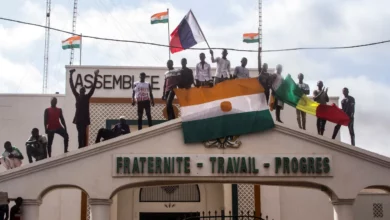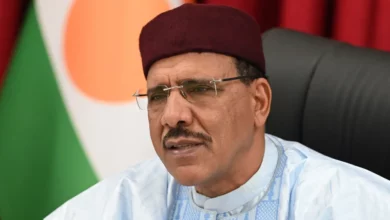Having accepted an invitation to attend a meeting of the Coalition to Protect the Revolution, mathematics professor Mina Abdel Malek left unsatisfied and confused, asking the same questions that many Egyptians are asking regarding the approximately 200 revolution coalitions now active in Egypt.
“Until now I still don’t know who is in this coalition, I don’t know where they hold their meetings, I don’t know what their role is. All I know is that these are power-loving people who are creating pretend coalitions and speaking in their names. Where are those faithful to this country?” Abdel Malek wrote in a letter to the state-run daily newspaper Al-Ahram.
Following President Hosni Mubarak’s resignation in February due to pressure from a largely leaderless uprising, the number of “revolutionary coalitions” increased dramatically. At the same time, so did the gaps between them, with each coalition perceiving its role differently.
The first revolutionary youth coalition emerged one week before the protests that launched the revolution. On 18 January the group that became known as the Youth of the Revolution Coalition was formed, uniting all the movements calling for the 25 January protests. During the 18-day uprising, the coalition decided the course of the protests, acted as an intermediary between the people and officials and was the face of the revolution in the media.
But since then, things have become more fractured. While most political forces were satisfied with the role the coalition played during the uprising, the fast-rising number of coalitions that emerged since Mubarak’s 11 February departure is now a cause of concern.
“It is very important for coalitions to try to merge together now because the continued large number [of coalitions] discredits youth movements and gives the impression that their leaders are only interested in leadership and not in the effectiveness of their work,” says Mostafa Kamel el-Sayed, a professor of political science at the American University in Cairo.
Some leaders of the newer coalitions blame the emergence of so many new entities on the original Youth of the Revolution Coalition.
“The Youth of the Revolution Coalition shut down on itself and refused to let anybody else in,” said Haitham el-Shawaf, a member of the Alliance of Revolutionary Forces, another coalition group. “When we found that the [Youth of the Revolution] coalition was taking a path that is contradictory to the revolution, the other entities started to emerge.”
Other young revolutionaries, however, think the emergence of other groups is a normal and healthy political phenomenon.
Abdallah Helmy, a member of the Youth of the Revolution Union, sees that this stage in the revolution requires the presence of many coalitions to represent differing points of view, as opposed to the days of the uprising when the fall of Mubarak was the unifying goal and the Tahrir sit-in the unanimously chosen tool.
“There are now contradictory demands, so there must be different lobby groups for each one,” he says.
But even Sayed admits that while ideological differences justify having a handful of coalitions, the unnecessary fragmentation into hundreds of groups is driven by personal ambition.
“The division between youth groups is not ideological,” he says. “It relates more to personal ambitions and a general disease in Egyptian society, which is the lack of collective work mentality.”
“The same thing is happening in parties, but we expected young people to be free of that disease,” he adds.
Many of Egypt’s traditional opposition parties are also seeing a great degree of fragmentation. The liberal Wafd Party, Egypt’s oldest, is facing an internal upheaval. And a faction of youth from the Muslim Brotherhood, Egypt’s best-organized political movement, recently split off into its own party.
The 6 April Movement, the Coalition of Revolutionary Forces and the Youth of the Revolution Union have all encountered severe internal rifts resulting in their division into new entities. While the movements claim that the differences are ideological, a struggle for power is obviously a factor.
“We started the coalition with the understanding that we will forget ourselves and serve Egypt, but when personalities started to take over, that’s when the problems happened and we left,” says Mohamed Adel, one of the founders of the Alliance for Egypt, which was formed by members of the Alliance of Revolutionary Forces, who split from the group following an internal power struggle.
Some coalitions are still holding on to their original role of mobilizing for protests; others have moved on to other forms of political participation.
The Alliance of Revolutionary Forces, in addition to the anonymous group that called for the 27 May protest to be a “second revolution”, are adamant about escalating protest tactics until the remainder of the revolution’s demands are met, including the release of political prisoners and writing a new constitution.
The Youth of the Revolution Union chose the diplomatic path as it is focused on negotiations with the ruling military council and the government, while the original Youth of the Revolution Coalition considers its current role to be “managing the transitional phase” and is adopting political and economic initiatives.
New calls for protests on 8 July exemplify the differences between the coalitions, with plans for the day varying greatly. While the Alliance of Revolutionary Forces calls for an open-ended sit in that could escalate into civil disobedience if their demands go unmet, the Alliance for Egypt calls only for a protest. The Youth of the Revolution Coalition, meanwhile, hasn’t yet determined its position.
The one goal that most coalitions have united on (a few withstanding) is pushing for a new constitution before parliamentary elections currently scheduled for November. There is an ongoing campaign that many coalitions are collaborating on, which aims to collect 15 million signatures supporting this demand.
Sayed believes that focusing most of their time on such issues is damaging the groups’ credibility. He suggests that coalitions should dedicate less time to political issues and more time to finding solutions to the most pressing problems in Egypt, such as security and congestion in urban areas.
While experts suggest reforms to be introduced to coalitions, many activists believe that their role is over now and they should expire altogether.
Alaa Abdel Fatah, a prominent blogger and activist, calls the youth coalitions “an opportunist faction”, believing that they should be replaced by specialized groups calling for the rights of various sectors of society.
Criticism of the revolutionary coalitions does not only come from the public; the coalitions themselves are often highly critical of each other. Those who wish to escalate the pressure on the authorities call those who engage in negotiations with members of the government “sell-outs” and “regime agents”, while the latter say the calls for continued protests are destructive.
Nasser Abdel Hamid, a member of the original Youth of the Revolution Coalition, denies allegations that the coalition collaborates with newer groups, dismissing them as inactive.
“We will coordinate with them when they come into existence, but the coalition coordinates with groups that actually work on the ground,” says Abdel Hamid.
If the role of the youth coalitions is unclear now, it will get more confusing after the parliamentary elections, when there will be elected representatives with the legitimacy to take over the powers that the coalitions now possess.
Most coalitions say they plan to field candidates for parliament, while some members plan to join civil society organizations and others plan to continue working in the coalition as a lobbying group.




